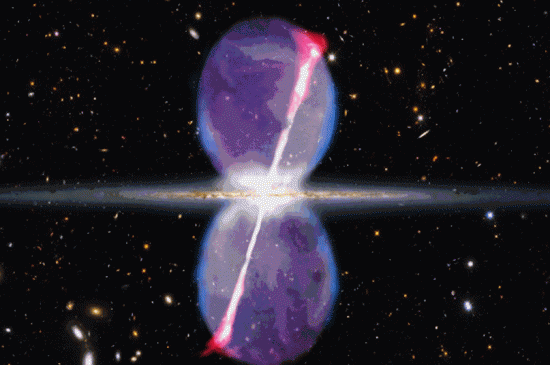
Gamma ray “bubbles” and a tilted jet are seen erupting from the center of the Milky Way in this artist’s conception. Credit: David A. Aguilar/CfA
August 22, 2012
Astronomers continue to ignore electricity in space, opting for outdated ideas about gravity and heat.
Recently, astronomers from the Harvard-Smithsonian Center for Astrophysics announced that our own Milky Way galaxy is expelling enormous jets of gamma rays from a putative supermassive black hole residing in its nucleus. In 2010, twin funnels of gamma ray emissions were detected above and below the galactic plane, measuring 65,000 light-years in diameter.
According to conventional cosmological theories, black holes are formed when a star with a mass approximately five times that of our Sun uses up its thermonuclear fuel and collapses under the force of its own gravity. Because the equations that describe gravity can be manipulated in irrational ways, some solutions imply that such a large star can contract into a zero volume containing nearly infinite inertial mass. Astrophysicists have contended for years that black holes are real and that their effects can be observed, although they are invisible to detection.
As the theories suggest, black holes possess a gravitational attraction of such intensity that not even electromagnetic radiation can escape the event horizon. Thus, no direct evidence of a black hole’s existence can be measured, only the hypothetical effects of the extreme gravity. Such effects are said to be gamma rays, X-rays and extreme ultraviolet radiation from the gases and dust as they are compressed into smaller and smaller spaces before being drawn down into oblivion.
Explaining the jets of ionized particles often seen erupting from various galaxies and quasars ranks as one of the most difficult tasks facing modern astronomers. What force can create highly energetic particle emissions that span distances measured in light-years? What confines them into narrow beams?The prevailing theory of “compacted gravitational point sources” exciting gas and dust as they orbit does not address the existence of collimated jets. There is only one force that can hold such a matter stream together over those distances: magnetism.
The only way to generate that magnetic confinement is through electricity flowing through space.
In the past, astronomers observed coherent filaments from galaxies like M87, which extend for thousands of light-years. Charged particles within the filaments are thought to exceed velocities of 500 kilometers per second.
Galaxies are nodes in cosmic electrical circuits. Electromagnetic energy could be stored in the equatorial current sheets surrounding them until some trigger event causes them to switch into a polar discharge. The electric jet could receive its energy from a natural particle-accelerator, a “plasma double layer” with a strong electric field. Toroidal magnetic fields would form because of the polar plasma discharge, confining it into a narrow channel.
Axial electric currents should be flowing along the jet’s entire length. Only electric fields can accelerate charged particles across space.
In previous Picture of the Day articles, we have taken issue with the very idea of black holes and the indirect “evidence” for them that has been presented by the scientific community. Any substance hot enough to emit gamma rays is not a gas but is ionized plasma. What the Harvard-Smithsonian scientists fail to realize is that the gamma rays they are seeing are synchrotron radiation and not the incandescent glow of hot gas. The gamma rays, as well as X-rays and ultraviolet light, are due to electrons spiraling along helical magnetic fields.
The black holes whose effects are supposed to be influencing time and space throughout the Universe are convenient ways to explain away the amazing forces of electric currents permeating space.
Stephen Smith












